
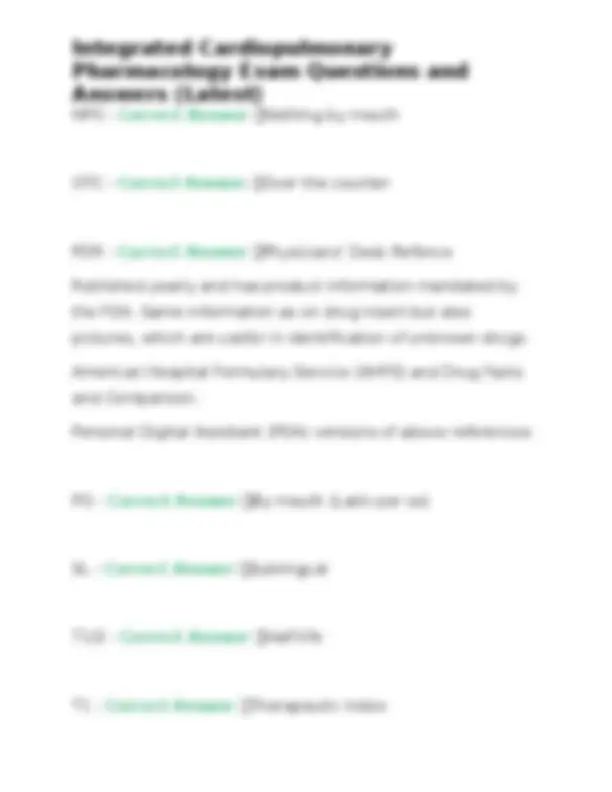
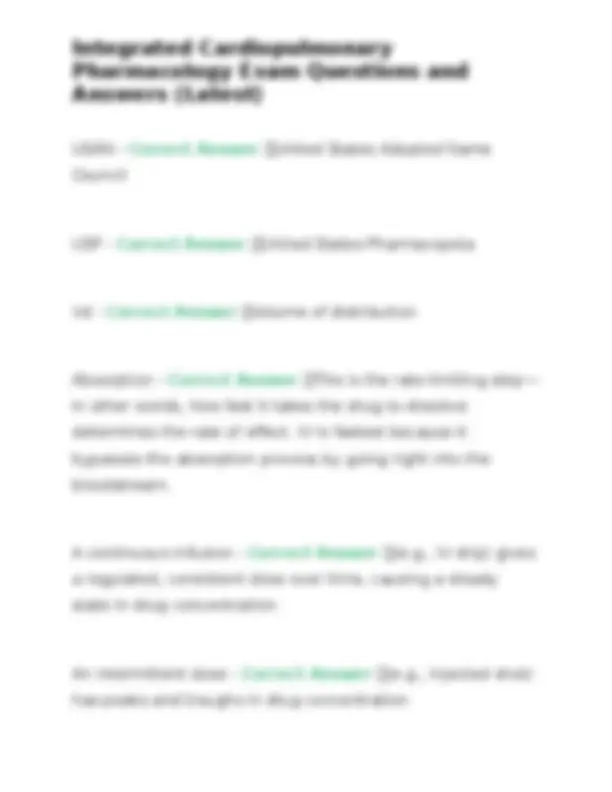
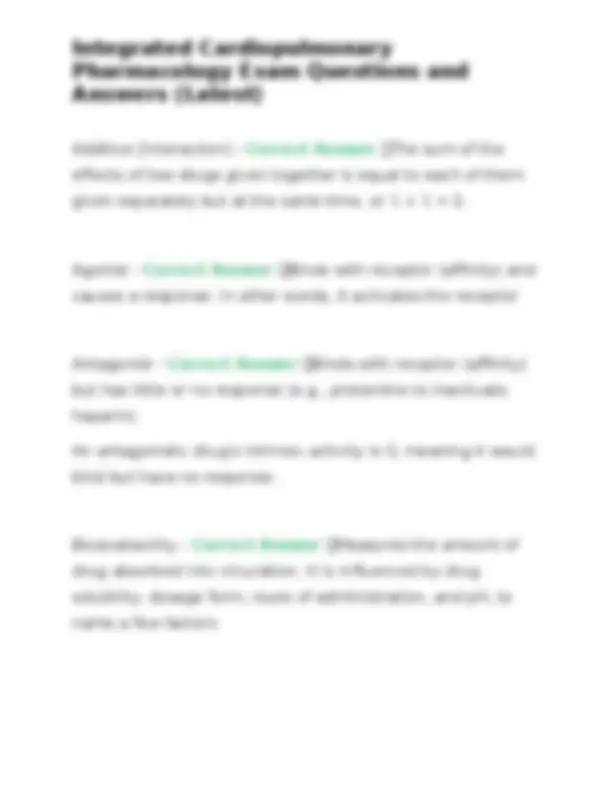
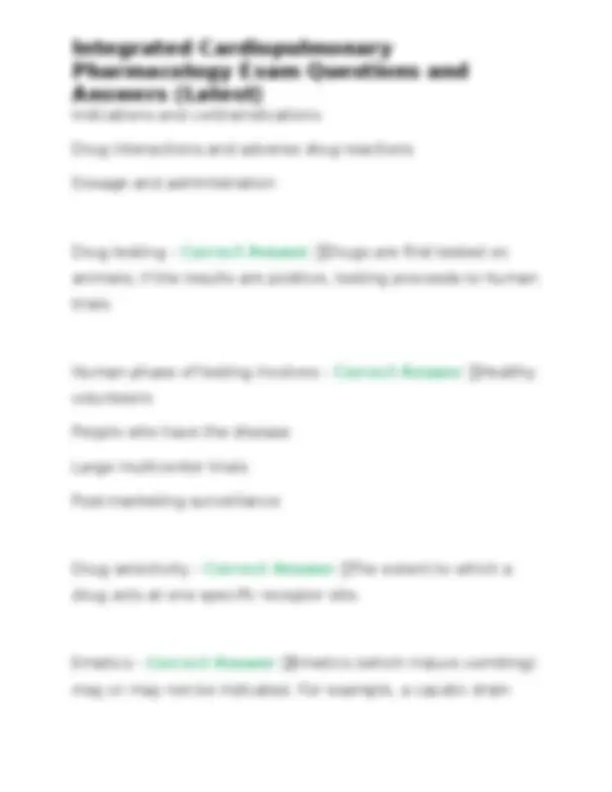
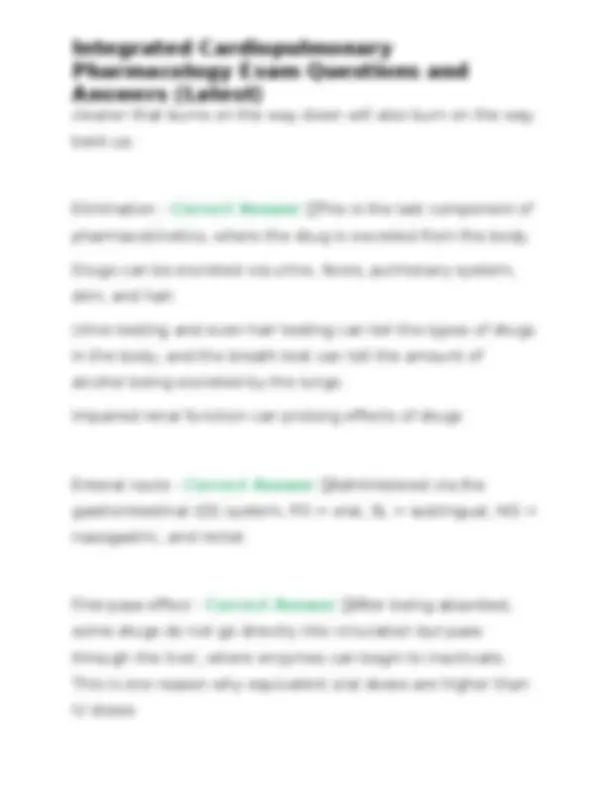

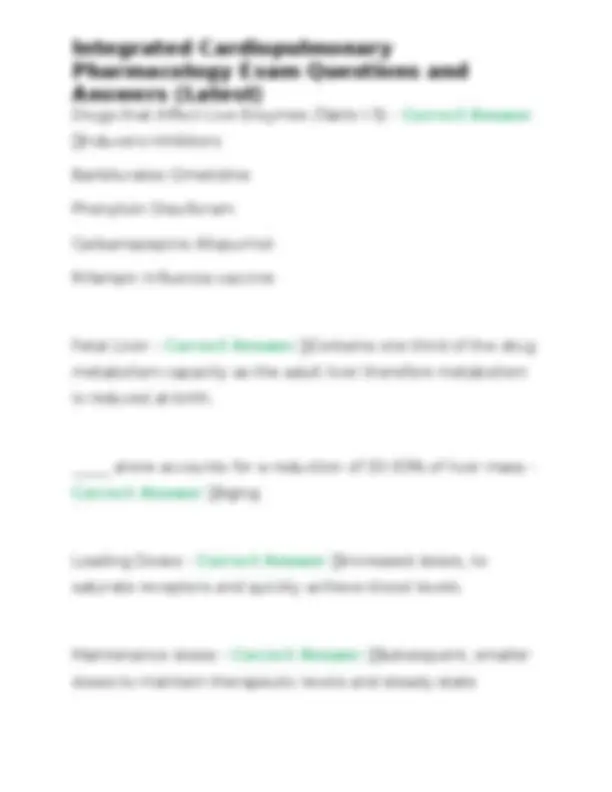
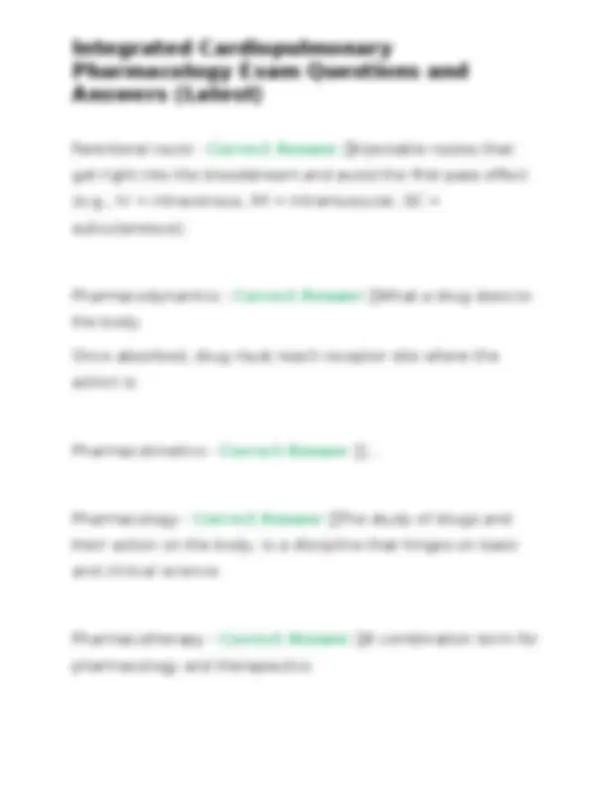
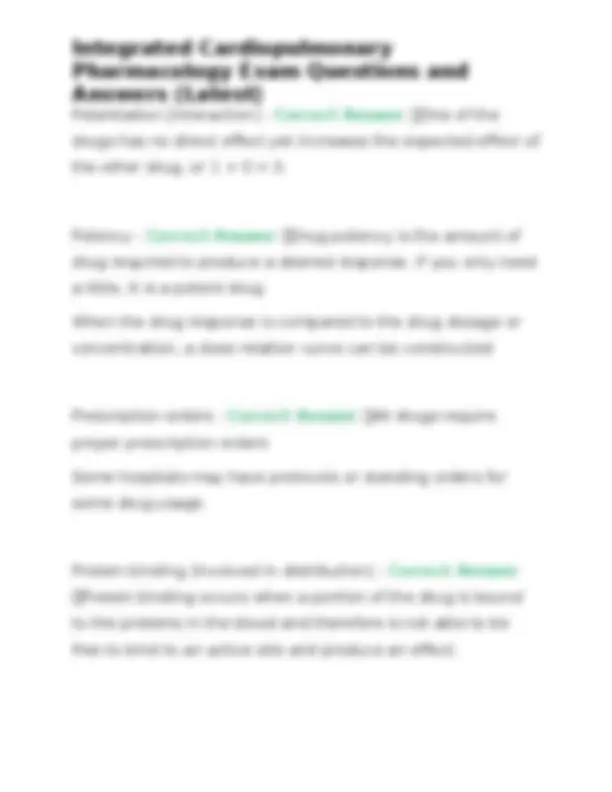
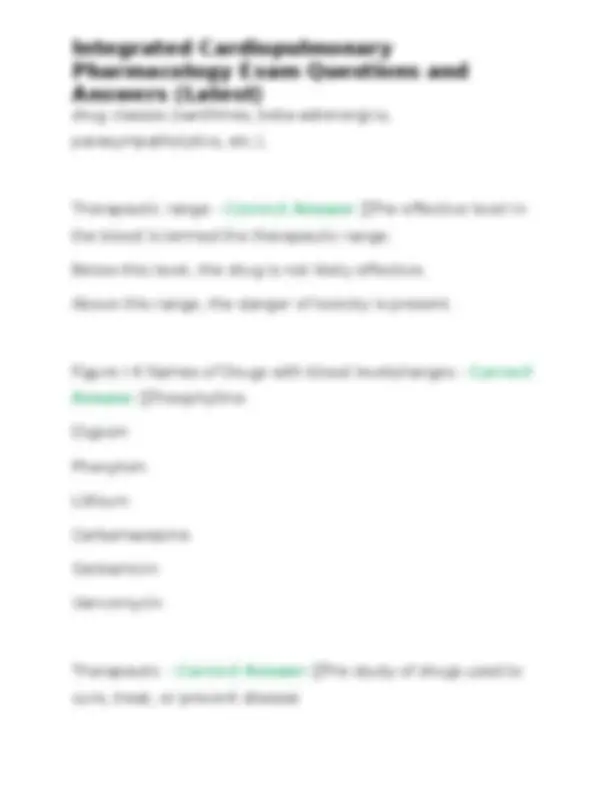
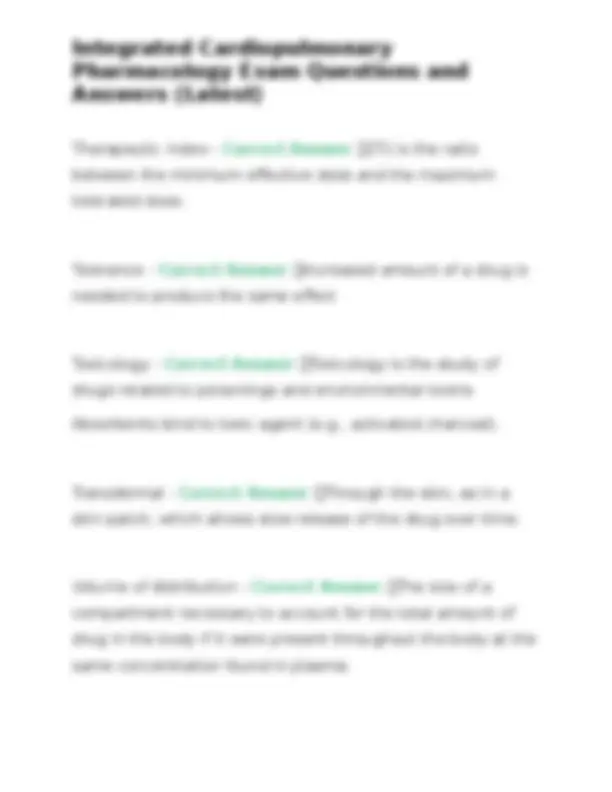
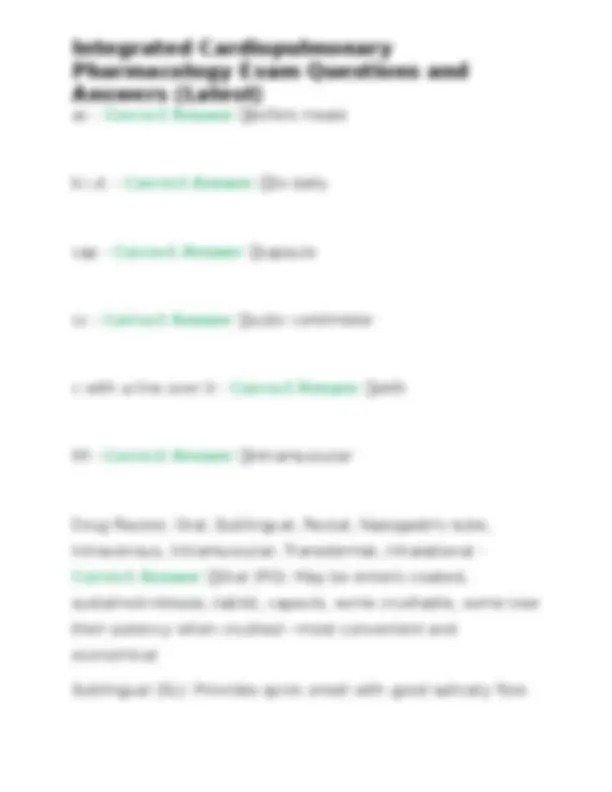
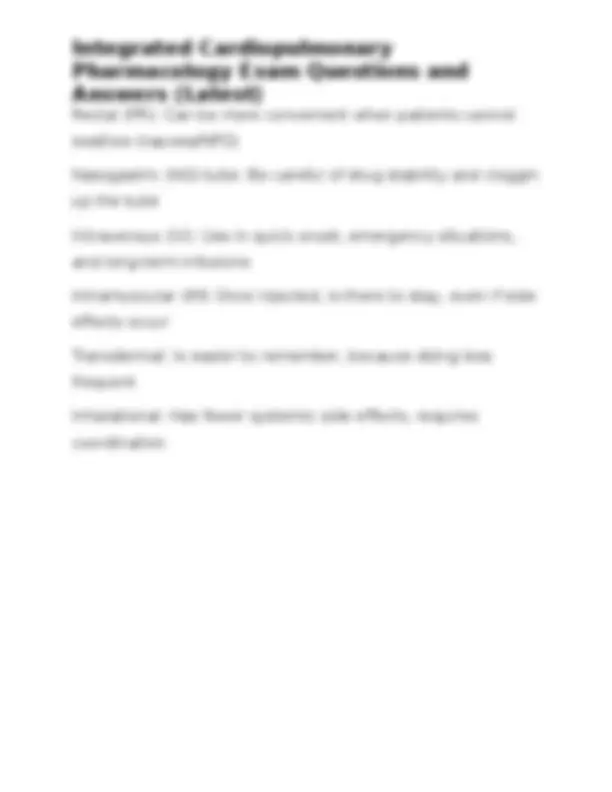


Study with the several resources on Docsity

Earn points by helping other students or get them with a premium plan


Prepare for your exams
Study with the several resources on Docsity

Earn points to download
Earn points by helping other students or get them with a premium plan
Community
Ask the community for help and clear up your study doubts
Discover the best universities in your country according to Docsity users
Free resources
Download our free guides on studying techniques, anxiety management strategies, and thesis advice from Docsity tutors
A comprehensive overview of integrated cardiopulmonary pharmacology, covering a wide range of topics such as drug absorption, distribution, metabolism, and elimination, as well as common drug interactions, adverse drug reactions, and pharmacokinetic principles. It includes a detailed examination of various drugs and their effects on the cardiovascular and respiratory systems, with a focus on key concepts, definitions, and exam-style questions and answers. The document serves as a valuable resource for healthcare professionals, students, and researchers interested in understanding the pharmacological management of cardiopulmonary conditions.
Typology: Exams
1 / 21

This page cannot be seen from the preview
Don't miss anything!














ACE - Correct Answer ✅Angiotensin-converting enzyme ADR - Correct Answer ✅Adverse drug reaction Can range from a mild rash to a life- threatening loss of blood pressure: allergies, headaches, bronchospasm, tremors, and photosensitivity. What is one of the most serious ADRs? - Correct Answer ✅A hypersensitivity reaction which can present itself as acute pulmonary edema, bronchial asthma, pulmonary fibrosis, or respiratory muscle impairment How many drugs have been shown to cause pulmonary ADRs? - Correct Answer ✅More than 150 drugs AHFS - Correct Answer ✅American Hospital Formulary Service CNS - Correct Answer ✅Central nervous system
COPD - Correct Answer ✅Chronic obstructive pulmonary disease DNA - Correct Answer ✅Deoxyribonucleic acid FDA - Correct Answer ✅Food and Drug Administration Regulates testing and approves new drugs in the U.S. market GI - Correct Answer ✅Gastrointestinal HIV - Correct Answer ✅Human immunodeficiency virus IM - Correct Answer ✅Intramuscular IV - Correct Answer ✅Intravenous NG - Correct Answer ✅Nasogastric
USAN - Correct Answer ✅United States Adopted Name Council USP - Correct Answer ✅United States Pharmacopeia Vd - Correct Answer ✅Volume of distribution Absorption - Correct Answer ✅This is the rate-limiting step— In other words, how fast it takes the drug to dissolve determines the rate of effect. IV is fastest because it bypasses the absorption process by going right into the bloodstream. A continuous infusion - Correct Answer ✅(e.g., IV drip) gives a regulated, consistent dose over time, causing a steady state in drug concentration An intermittent dose - Correct Answer ✅(e.g., injected shot) has peaks and troughs in drug concentration
Additive [Interaction] - Correct Answer ✅The sum of the effects of two drugs given together is equal to each of them given separately but at the same time, or 1 + 1 = 2. Agonist - Correct Answer ✅Binds with receptor (affinity) and causes a response. In other words, it activates the receptor Antagonist - Correct Answer ✅Binds with receptor (affinity) but has little or no response (e.g., protamine to inactivate heparin). An antagonistic drug's intrinsic activity is 0, meaning it would bind but have no response. Bioavailavility - Correct Answer ✅Measures the amount of drug absorbed into circulation. It is influenced by drug solubility, dosage form, route of administration, and pH, to name a few factors
Desensitization - Correct Answer ✅Long-term exposure of drug to cell or tissue makes it less responsive over time. Disease management - Correct Answer ✅Collective management of all aspects of disease and not just the pharmacotherapy. Distribution - Correct Answer ✅Major vehicle for distribution is the bloodstream. Several things can affect distribution, such as blood flow, fat or water solubility, or protein binding. Drug development - Correct Answer ✅Drugs are derived from a variety of sources, including plants, animals, minerals, chemicals, and recombinant DNA. Most drugs are now chemically synthesized, but in the future, many may be bioengineered. Drug Inserts - Correct Answer ✅Drug names Clinical pharmacology
Indications and contraindications Drug interactions and adverse drug reactions Dosage and administration Drug testing - Correct Answer ✅Drugs are first tested on animals; if the results are positive, testing proceeds to human trials Human phase of testing involves - Correct Answer ✅Healthy volunteers People who have the disease Large multicenter trials Post-marketing surveillance Drug selectivity - Correct Answer ✅The extent to which a drug acts at one specific receptor site. Emetics - Correct Answer ✅Emetics (which induce vomiting) may or may not be indicated. For example, a caustic drain
Figure 1-8: The first pass effect. Drugs administered orally are first absorbed through the small intestine and then enter the liver where they begin to be metabolized (broken down) before reaching the bloodstream. Formulary - Correct Answer ✅A list of drugs available at a particular health care system (drug stock at hand). Generic Name - Correct Answer ✅Given by United States Adopted Names (USAN) Council. Not owned by a particular company, called the nonproprietary name, and usually written in lowercase. Half-life (T1/2) - Correct Answer ✅Time it takes for concentration of drug to decrease by one-half after administration. Drugs with short half-lives don't stay in the body long Liver Disease can increase half-life, causing drugs to stay around longer and have greater-than-expected effects Drug Half Lives (Table I-6) - Correct Answer ✅Digoxin
Aminoglycosides Theophylline Albuterol Warfarin Heparin Herbals (Neutraceuticals) - Correct Answer ✅Used in complementary or integrative medicine. Little control of dosage, purity, and contaminants. Herbal medicine has valid use but must be studied and undergo controlled production. Many interactions with prescribed drugs Inhalation - Correct Answer ✅Inhaled into the lungs and absorbed into the pulmonary capillaries Intrinsic activity - Correct Answer ✅Measure of drugs effectiveness of causing a response (efficacy). Example:
Drugs that Affect Live Enzymes (Table I-5) - Correct Answer ✅Inducers Inhibitors Barbiturates Cimetidine Phenytoin Disulfuram Carbamazepine Allopurinol Rifampin Influenza vaccine Fetal Liver - Correct Answer ✅Contains one third of the drug metabolism capacity as the adult liver therefore metabolism is reduced at birth. _____ alone accounts for a reduction of 20-30% of liver mass - Correct Answer ✅Aging Loading Doses - Correct Answer ✅Increased doses, to saturate receptors and quickly achieve blood levels. Maintenance doses - Correct Answer ✅Subsequent, smaller doses to maintain therapeutic levels and steady state
Parenteral route - Correct Answer ✅Injectable routes that get right into the bloodstream and avoid the first-pass effect (e.g., IV = intravenous, IM = intramuscular, SC = subcutaneous). Pharmacodynamics - Correct Answer ✅What a drug does to the body. Once absorbed, drug must reach receptor site where the action is. Pharmacokinetics - Correct Answer ✅... Pharmacology - Correct Answer ✅The study of drugs and their action on the body, is a discipline that hinges on basic and clinical science. Pharmacotherapy - Correct Answer ✅A combination term for pharmacology and therapeutics
Racemic - Correct Answer ✅Many drugs are available in racemic mixtures, which contain two different isomers. An isomer has the exact elemental components but the molecular arrangement is different. Each isomer can have different pharmacologic activity Receptor - Correct Answer ✅When a Drug Binds to a Receptor, Three Things May Happen:
Aspirin Phenytoin Theophylline Selectivity - Correct Answer ✅... Steady State - Correct Answer ✅... Sublingual - Correct Answer ✅... Synergism [Synergistic interaction] - Correct Answer ✅Giving two drugs together results in a greater effect than expected if given separately, or 1 + 1 = 3. Teratogenic - Correct Answer ✅... Therapeutic classification - Correct Answer ✅Drugs are classed or grouped according to the drug use. For example, therapeutic classification of bronchodilators can have several
Therapeutic index - Correct Answer ✅(TI) is the ratio between the minimum effective dose and the maximum tolerated dose. Tolerance - Correct Answer ✅Increased amount of a drug is needed to produce the same effect Toxicology - Correct Answer ✅Toxicology is the study of drugs related to poisonings and environmental toxins Absorbents bind to toxic agent (e.g., activated charcoal). Transdermal - Correct Answer ✅Through the skin, as in a skin patch, which allows slow release of the drug over time. Volume of distribution - Correct Answer ✅The size of a compartment necessary to account for the total amount of drug in the body if it were present throughout the body at the same concentration found in plasma.
ac - Correct Answer ✅before meals b.i.d. - Correct Answer ✅2x daily cap - Correct Answer ✅capsule cc - Correct Answer ✅cubic centimeter c with a line over it - Correct Answer ✅with IM - Correct Answer ✅intramuscular Drug Routes: Oral, Sublingual, Rectal, Nasogastric tube, Intravenous, Intramuscular, Transdermal, Inhalational - Correct Answer ✅Oral (PO): May be enteric-coated, sustained-release, tablet, capsule, some crushable, some lose their potency when crushed---most convenient and economical Sublingual (SL): Provides quick onset with good salivary flow